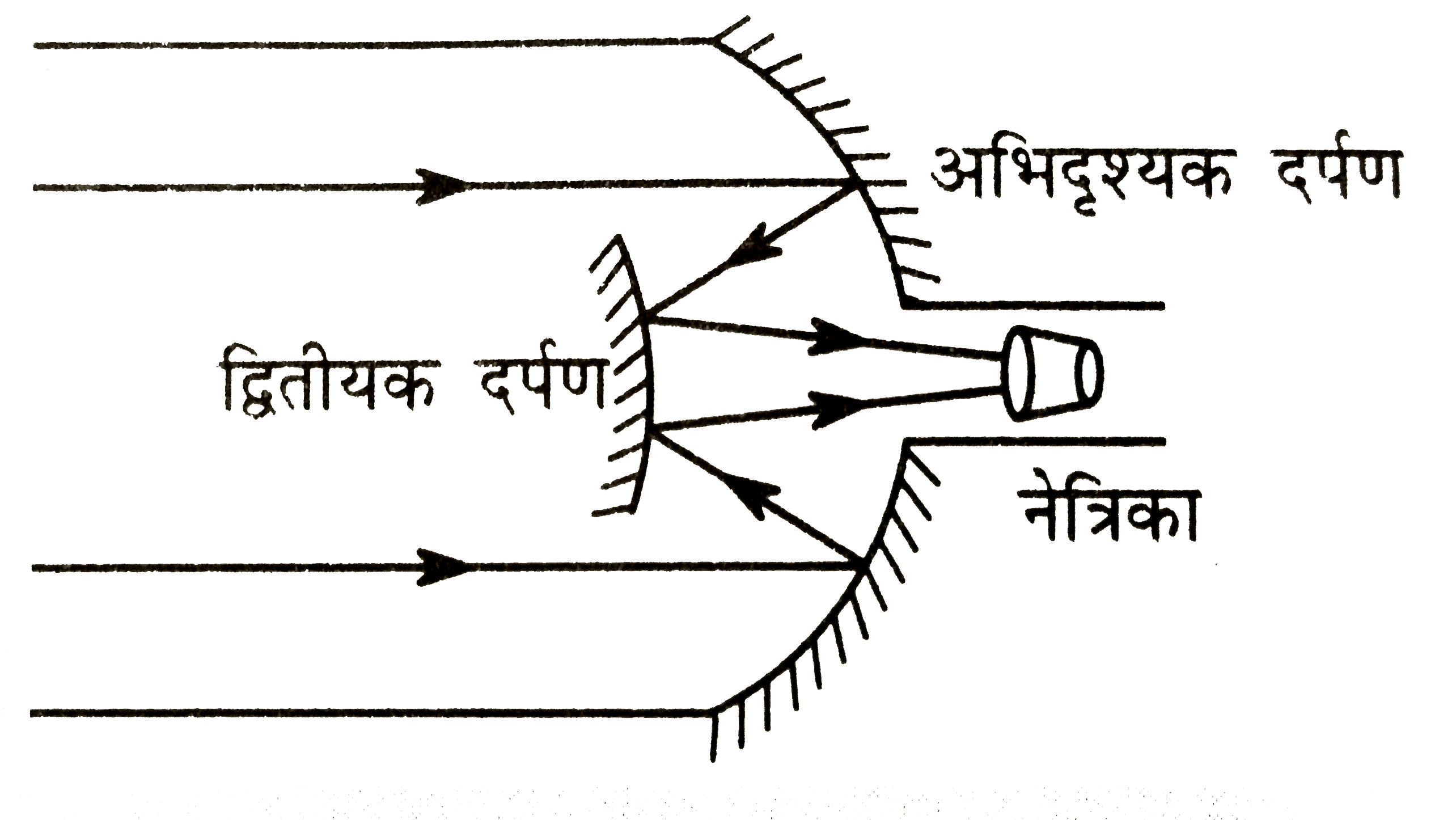A Cassegrain telescope uses two mirrors. Such a telescope is bult with the mirrors 20mm apart. If the radius of carvature of the large mirror is 220mm and the small mirror is 140 mm, where will the final image of an object at infinity be ? Solution in Tamil
f0=2202=110 mm
Object at infinity forms an image at 110 cm. This image will act as a yirtual object for the smaller mirror .
Distance of virtual object from smaller mirror
u = 110 - 20 90 mm
fe=1402=70 mm
Using 1v+1u=1fs⇒1v=1fs−1u=170−190=1315mm
v = 315 mm
i.e., Final image is 315 mm from smaller mirror on the righ side
Topper's Solved these Questions
- RAY OPTICS AND OPTICAL INSTRUMENTS BOOK - NEW JOYTHI PUBLICATIONCHAPTER - RAY OPTICS AND OPTICAL INSTRUMENTS EXERCISE - PRACTICE PROBLEMS FOR SELF ASSESSMENT
20 Videos
- RAY OPTICS AND OPTICAL INSTRUMENTS BOOK - NEW JOYTHI PUBLICATIONCHAPTER - RAY OPTICS AND OPTICAL INSTRUMENTS EXERCISE - EVALUATION QUESTION AND ANSWERS
30 Videos
- RAY OPTICS AND OPTICAL INSTRUMENTS BOOK - NEW JOYTHI PUBLICATIONCHAPTER - RAY OPTICS AND OPTICAL INSTRUMENTS EXERCISE - COMPETITIVE EXAM CORNER
26 Videos
- NUCLEIBOOK - NEW JOYTHI PUBLICATIONCHAPTER - NUCLEIEXERCISE - COMPETITIVE EXAM CORNER
23 Videos
- SEMICONDUCTOR ELECTRONICS : MATERIALS , DEVICES AND SIMPLE CIRCUITS BOOK - NEW JOYTHI PUBLICATIONCHAPTER - SEMICONDUCTOR ELECTRONICS : MATERIALS , DEVICES AND SIMPLE CIRCUITS EXERCISE - COMPETITIVE EXAM CORNER
37 Videos
Similar Questions
Use the mirror formula to show that for an object between the pole and focus of a concave mirror, the image formed is virtual .
View SolutionA convex lens is placed in water.
a. Will there be any change in its focal length? B. Give reason.
View SolutionA 100 W bulb produces an electric field of 2.9 V/m at a point 3m away. If the bulb is replaced by 400 W bulb without disturbing other conditions. Then the electric field produced at the same point is
View SolutionRadioactive 6027Co is transformed into stable 6028Ni by emitting two γ - rays of energies
View SolutionA pure semiconductor has equal electron and hole concentration of 1016m−3 . Doping by indium increases nh to 5×1022m−3 . Then the value of ne in the doped semiconductor is
View SolutionA Cassegrainian telescope uses two mirrors as shown in Fig. Such a telescope is built with the mirrors 20mm apart. If the radius of curvature of large mirror is 220mm and the small mirror is 40mm, where will the final image of an object at infinity be ?

View Solutionकिसी कैसेग्रेन दूरबीन में चित्र में दर्शाए अनुसार दो दर्पणों का प्रयोग किया गया है| इस दूरबीन में दोनों दर्पण एक-दूसरे से 20 सेमीo दूर रखे गए है |यदि बड़े दर्पण की वक्रता त्रिज्या 220 मिमीo हो तथा छोटे दर्पण की वक्रता त्रिज्या 140 मिमीo हो तो अनन्त पर रखे किसी बिम्ब का अन्तिम प्रतिबिम्ब कहाँ बनेगा ?

View SolutionAssertion :- In a cassegrain telescope objective mirror is parabolic in place of spherical
Reason :- No chromatic aberration in parabolic mirror
View SolutionA cassegrain telescope is built with the mirrors 20 mm apart. If the radius of curvature of the larger mirror is 220 mm and the small mirror is 140 mm. where will the final image of an object at infinity be ?
View Solutionकिसी कैसेग्रेन दूरबीन में चित्र में दर्शाए अनुसार दो दर्पणों का प्रयोग किया गया है । इस दूरबीन में दोनों दर्पण एक -दूसरे से 7cm दूर रखे गए हैं। यदि बड़े दर्पण की वक्रता -त्रिज्या 22cm तथा छोटे दर्पण की वक्रता -त्रिज्या 14cm हो ,तो अन्नत पर रखे किसी बिंब का अंतिम प्रतिबिंब कहाँ बनेगा ?

View SolutionA Cassegrain telescope is built with mirrors 20 mm apart. If the radius of curvature of the large mirror is 220 mm and the small mirror is 140 mm, then where will the final image of an object at infinty be?
View Solutionकिसी कैसेग्रेन दूरबीन में दर्शाए अनुसार दो दर्पणों का प्रयोग किया गया है | इस दूरबीन में दोनों दर्पण एक - दूसरे से 20mm दूर रखे गए है | यदि बड़े दर्पण की वक्रता त्रिज्या 220mm हो तथा छोटे दर्पण की वक्रता त्रिज्या 140mm हो तो अनंत पर रखे किसी बिंब का अंतिम प्रतिबिंब कहाँ बनेगा ?
View Solution_______ mirrors are used in relfecting telescope.
View SolutionA Cassegrain telescope uses two mirrors of radii of curvature 220 mm and 140 mm. The distance b/w the two mirrors is 20 mm. Where will the final image of an object at infinity be?
View SolutionIn a Cassegrainian telescope, ……………………. is a large concave mirror.
View Solution
